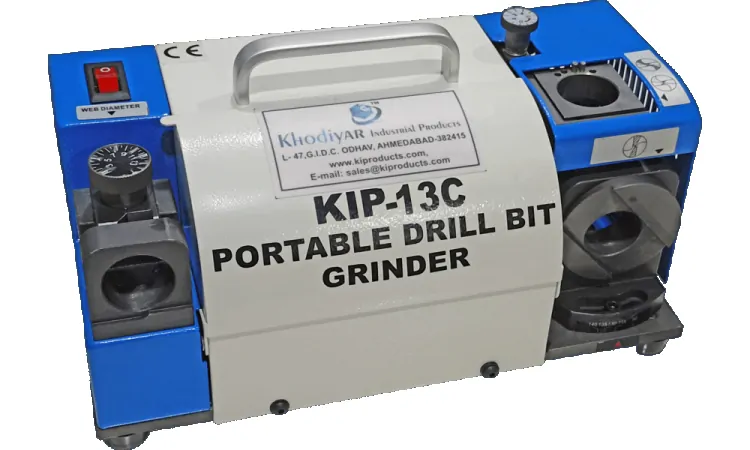The Evolution of Drill Bit Grinding Machines in Modern Manufacturing
In the fast-paced world of modern manufacturing, precision tools are essential for achieving high-quality results.

Among these tools, the universal cutter grinder machine plays a pivotal role, especially in the grinding and sharpening of drill bits and cutting tools. The evolution of drill bit grinding machines reflects the advancements in technology and the changing demands of the manufacturing sector, particularly in India.
Historical Overview
The journey of drill bit grinding machines can be traced back to the early 20th century. Initially, craftsmen relied on manual sharpening methods, which were time-consuming and often resulted in inconsistent quality. As manufacturing began to grow, the need for more efficient and precise tools became apparent.
The mid-20th century saw the introduction of electric grinding machines, which improved the speed and uniformity of the sharpening process. These machines quickly became staples in workshops, allowing operators to sharpen multiple tools more quickly than ever before.
By the late 20th century, the development of computer numerical control (CNC) technology revolutionized the industry, enabling automated and highly precise grinding operations. The introduction of universal cutter grinder machines marked a significant leap, allowing manufacturers to sharpen a variety of cutting tools beyond just drill bits. This versatility made them indispensable in various manufacturing settings.
Features of Modern Machines
Today’s drill bit grinding machines are equipped with advanced features that cater to the needs of modern manufacturing. High-precision grinding capabilities ensure that drill bits maintain their sharpness and geometry. Universal cutter grinders can handle various tool types, including end mills, reamers, and taps, enhancing their utility across different applications.
User-friendly interfaces have become a standard in modern machines, allowing operators to easily set parameters and monitor grinding processes. Additionally, safety features such as automatic shut-off mechanisms and protective guards enhance the overall safety of machine operations. Energy efficiency is another critical consideration; newer models are designed to consume less energy, aligning with the growing emphasis on sustainability in manufacturing.
Importance of Drill Bit Grinding
Drill bit grinding is essential for maintaining tool performance and ensuring operational efficiency. Regular grinding and sharpening extend the life of drill bits, reducing the need for frequent replacements, which translates to significant cost savings. Well-sharpened bits produce cleaner holes and cuts, directly enhancing the quality of the final product.
Moreover, efficient grinding machines reduce downtime associated with tool changes, allowing for smoother production processes. As manufacturing demands continue to evolve, the ability to quickly and effectively grind various tools ensures that companies remain competitive in the market.
The Role of Technology
Technological advancements have significantly influenced the evolution of drill bit grinding machines. CNC technology, for instance, allows for repeatable and precise grinding, reducing human error and improving consistency. Advanced software can handle complex tool geometries, ensuring that even the most intricate designs can be accurately sharpened.
The use of advanced materials in the construction of grinding wheels enhances durability and performance. Coatings applied to drill bits improve their resistance to wear and heat, further emphasizing the need for precision grinding. Furthermore, modern machines are often equipped with sensors that provide real-time data on tool performance, allowing for predictive maintenance and optimized operations. The integration of the Internet of Things (IoT) enables machines to communicate with each other and manufacturing systems, improving overall efficiency.
Future Trends
The future of drill bit grinding machines is promising, with several trends on the horizon. Increased customization options may allow manufacturers to tailor grinding processes to specific requirements, enhancing flexibility in production. Additionally, with a growing emphasis on sustainability, machines designed for minimal waste and energy consumption are likely to become standard.
The integration of artificial intelligence and machine learning will enable machines to adapt and optimize grinding processes based on historical data, further enhancing productivity. For Indian manufacturers, embracing these technological advancements will be crucial to compete effectively in the global market.
Conclusion
The evolution of drill bit grinding machines, particularly the universal cutter grinder machine, highlights the dynamic nature of modern manufacturing. With advancements in technology and a focus on precision and efficiency, these machines are essential for maintaining the quality and performance of cutting tools. As the Indian manufacturing sector continues to grow, investing in advanced grinding technologies will be vital for achieving sustainable success. By embracing these innovations, manufacturers can enhance productivity, reduce costs, and deliver high-quality outcomes for their customers.
What's Your Reaction?















